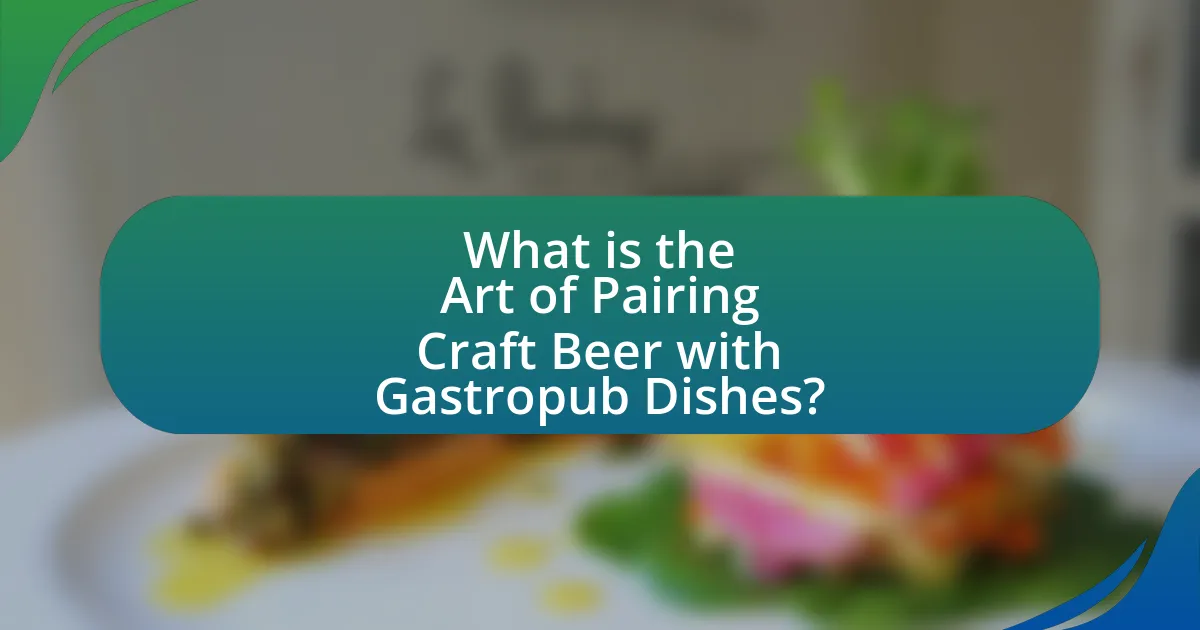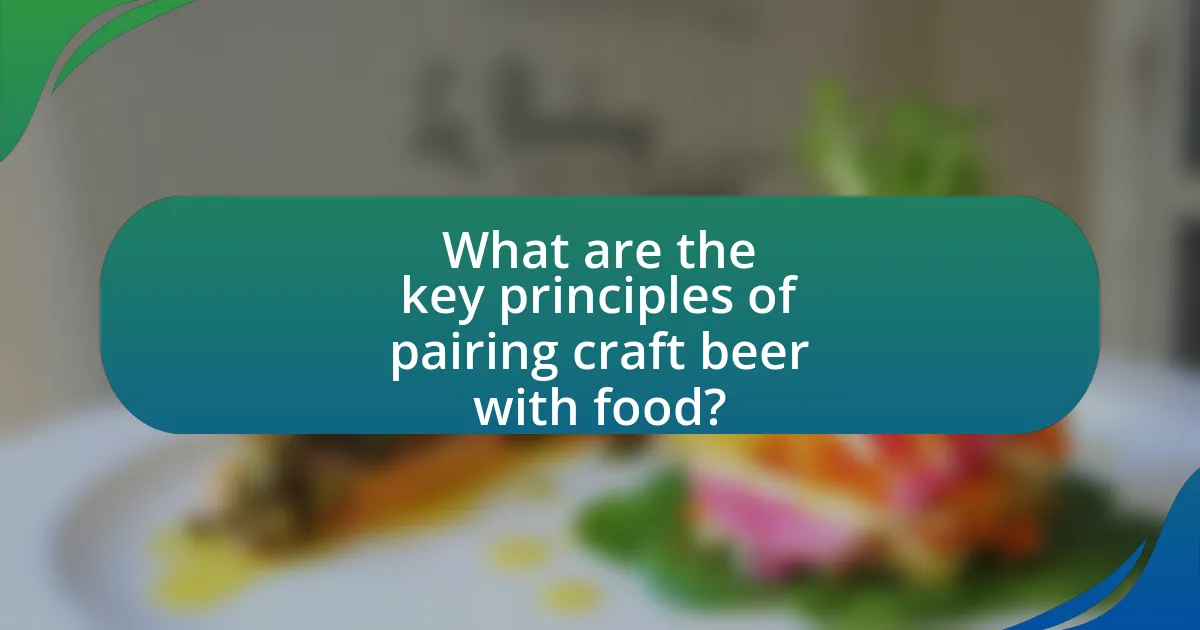The article focuses on the art of pairing craft beer with gastropub dishes, emphasizing how complementary flavors and textures can enhance the dining experience. It explores the characteristics of various beer styles, such as IPAs and stouts, and their interactions with different food types, highlighting key principles of pairing, including flavor profiles, intensity, and texture. Additionally, the article discusses the influence of seasonal ingredients on pairing choices and provides practical tips for diners to experiment with their own pairings while avoiding common mistakes. Overall, it underscores the significance of craft beer in elevating gastropub cuisine through thoughtful pairings.

What is the Art of Pairing Craft Beer with Gastropub Dishes?
The art of pairing craft beer with gastropub dishes involves selecting complementary flavors and textures to enhance the dining experience. Successful pairings consider the beer’s characteristics, such as bitterness, sweetness, and carbonation, alongside the dish’s ingredients and preparation methods. For example, a hoppy IPA can balance the richness of a fried dish, while a malty stout may complement the flavors of a chocolate dessert. Studies indicate that pairing beer with food can elevate both the beverage and the dish, creating a harmonious balance that enhances taste perception.
How does the pairing process enhance the dining experience?
The pairing process enhances the dining experience by creating complementary flavors that elevate both the food and beverage. When craft beer is paired with gastropub dishes, the unique characteristics of the beer, such as its bitterness, sweetness, or acidity, can enhance the taste profile of the food, leading to a more enjoyable meal. For instance, a hoppy IPA can cut through the richness of a creamy dish, while a malty stout can complement the sweetness of a dessert. This synergy not only improves flavor perception but also encourages exploration and appreciation of both the beer and the cuisine, making the overall dining experience more memorable.
What factors influence the choice of beer and dish pairings?
The choice of beer and dish pairings is influenced by flavor profiles, food texture, and the overall dining experience. Flavor profiles dictate how the bitterness, sweetness, acidity, and carbonation of beer complement or contrast with the flavors of a dish. For instance, a hoppy IPA can enhance spicy foods, while a malty stout may pair well with rich desserts. Food texture also plays a crucial role; lighter beers often complement lighter dishes, while heavier beers suit heartier meals. Additionally, the overall dining experience, including the occasion and personal preferences, shapes pairing choices, as consumers may opt for specific pairings based on mood or social context.
How do flavors in beer complement those in gastropub dishes?
Flavors in beer complement those in gastropub dishes by enhancing and balancing the overall taste experience. For instance, the bitterness of an IPA can cut through the richness of a creamy dish, while the malt sweetness in a stout can harmonize with chocolate desserts. Studies show that pairing beer with food can elevate flavors; for example, a 2018 study published in the Journal of Culinary Science & Technology found that specific beer styles can enhance the perception of umami in savory dishes. This synergy between beer and food creates a more enjoyable dining experience, making the flavors of both elements more pronounced.
Why is craft beer a popular choice for gastropub cuisine?
Craft beer is a popular choice for gastropub cuisine because it offers unique flavors that complement diverse dishes. The artisanal nature of craft beer allows for a wide range of styles, from hoppy IPAs to rich stouts, which can enhance the taste experience of food. Additionally, craft breweries often focus on local ingredients, aligning with the gastropub ethos of supporting local producers and creating fresh, seasonal menus. This synergy between craft beer and gastropub cuisine not only elevates the dining experience but also fosters a community-oriented atmosphere, making it a favored pairing among patrons.
What distinguishes craft beer from other types of beer?
Craft beer is distinguished from other types of beer primarily by its production methods, which emphasize small-scale brewing, traditional techniques, and unique flavors. Unlike mass-produced beers, craft beers are typically made by independent breweries that focus on quality ingredients, innovative recipes, and a variety of brewing styles. According to the Brewers Association, a craft brewery is defined as one that produces less than six million barrels annually, is independently owned, and emphasizes traditional or innovative brewing methods. This commitment to craftsmanship results in a diverse range of flavors and styles, setting craft beer apart from mainstream options.
How does the variety of craft beer styles impact pairing options?
The variety of craft beer styles significantly enhances pairing options by providing diverse flavor profiles that complement a wide range of dishes. Each beer style, such as IPAs, stouts, or lagers, offers unique characteristics like bitterness, sweetness, or acidity, which can either contrast with or enhance the flavors of food. For instance, a hoppy IPA can cut through the richness of fried foods, while a malty stout can complement the sweetness of desserts. This versatility allows chefs and enthusiasts to create tailored pairings that elevate the dining experience, supported by studies showing that specific beer and food combinations can enhance taste perception and enjoyment.

What are the key principles of pairing craft beer with food?
The key principles of pairing craft beer with food include complementing flavors, balancing intensity, and considering texture. Complementing flavors involves matching the beer’s taste profile with the dish, such as pairing a hoppy IPA with spicy foods to enhance the heat. Balancing intensity means aligning the strength of the beer with the richness of the food; for example, a robust stout can stand up to a hearty beef stew. Considering texture is also crucial; a crisp lager can cut through the creaminess of a rich cheese dish, providing a refreshing contrast. These principles are supported by culinary experts who emphasize the importance of harmony between beer and food for an enhanced dining experience.
How do flavor profiles affect beer and dish pairings?
Flavor profiles significantly influence beer and dish pairings by determining how complementary or contrasting flavors interact. For instance, a hoppy IPA with citrus notes can enhance the flavors of spicy dishes, while a malty stout may pair well with rich, chocolate desserts. Research indicates that pairing similar flavor profiles, such as a fruity beer with a fruit-based dish, can create a harmonious dining experience, while contrasting profiles can provide a balanced taste sensation. This principle is supported by studies in sensory analysis, which show that flavor compatibility enhances overall enjoyment and satisfaction in food and beverage pairings.
What are the primary flavor profiles found in craft beer?
The primary flavor profiles found in craft beer include hoppy, malty, fruity, sour, and roasted. Hoppy flavors often impart bitterness and citrus or pine notes, primarily derived from various hop varieties used in brewing. Malty profiles contribute sweetness and can range from caramel to chocolate flavors, depending on the malt types utilized. Fruity flavors, which can include notes of citrus, stone fruits, or tropical fruits, often arise from specific yeast strains or hop varieties. Sour profiles are characterized by tartness and can result from wild yeast or bacteria, while roasted flavors provide coffee or chocolate notes, typically from dark malts. These flavor profiles are essential for understanding how to pair craft beer effectively with gastropub dishes, enhancing the overall dining experience.
How can contrasting flavors create a balanced pairing?
Contrasting flavors create a balanced pairing by enhancing each other’s characteristics, leading to a more complex and enjoyable tasting experience. For example, the bitterness of a hoppy IPA can be balanced by the sweetness of a malty dish, allowing the flavors to complement rather than overpower one another. This principle is supported by the concept of flavor synergy, where contrasting elements, such as sweet and savory, can elevate the overall palate experience, making each component more pronounced. Studies in culinary arts demonstrate that pairings like spicy food with a refreshing lager can create a harmonious balance, showcasing how contrasting flavors can work together effectively.
What role does aroma play in the pairing process?
Aroma plays a crucial role in the pairing process by influencing the perception of flavors and enhancing the overall tasting experience. The olfactory senses contribute significantly to flavor perception, as approximately 80% of what we taste is derived from what we smell. In the context of pairing craft beer with gastropub dishes, the aroma of both the beer and the food can complement or contrast with each other, creating a harmonious balance or an intriguing juxtaposition. For example, a hoppy IPA with citrus notes can enhance the flavors of a dish featuring grilled seafood, while a malty stout with chocolate aroma can elevate a dessert. This interplay of aromas not only enriches the dining experience but also guides consumers in making informed pairing choices.
How can the aroma of beer enhance the flavors of a dish?
The aroma of beer can enhance the flavors of a dish by complementing and amplifying the dish’s existing flavors. The volatile compounds in beer, such as hops and malt, release aromatic notes that can interact with the taste buds and olfactory receptors, creating a more complex flavor experience. For example, a hoppy IPA can add citrus and floral notes that elevate the freshness of a seafood dish, while a malty stout can enhance the richness of chocolate desserts. Studies have shown that aroma plays a significant role in flavor perception, with research indicating that up to 80% of taste is influenced by smell. This synergy between beer aroma and food flavors can lead to a more enjoyable dining experience.
What techniques can be used to assess aroma in pairings?
Techniques to assess aroma in pairings include sensory evaluation, gas chromatography, and aroma wheel analysis. Sensory evaluation involves trained panels or consumer tastings to identify and describe aromas through direct experience. Gas chromatography provides a scientific method to separate and analyze volatile compounds in both beer and food, quantifying specific aroma components. Aroma wheel analysis categorizes aromas into distinct groups, aiding in the identification and comparison of aromas in pairings. These methods collectively enhance understanding of how aromas interact in craft beer and gastropub dish pairings.

What are some popular craft beer and gastropub dish pairings?
Popular craft beer and gastropub dish pairings include India Pale Ales (IPAs) with spicy chicken wings, stouts with chocolate desserts, and pale ales with fish and chips. IPAs, known for their hoppy bitterness, complement the heat of spicy wings, enhancing the overall flavor experience. Stouts, rich and creamy, pair well with chocolate desserts, as the beer’s roasted malt flavors intensify the sweetness of the chocolate. Pale ales, with their balanced profile, provide a refreshing contrast to the crispy texture and savory flavors of fish and chips. These pairings are widely recognized in the craft beer community for their ability to enhance both the beer and the dish.
What are classic pairings that work well together?
Classic pairings that work well together include India Pale Ales (IPAs) with spicy dishes, stouts with chocolate desserts, and pale ales with grilled meats. IPAs, known for their hoppy bitterness, complement the heat of spicy foods by balancing flavors. Stouts, rich and creamy, enhance the sweetness of chocolate desserts, creating a harmonious taste experience. Pale ales, with their moderate bitterness and fruity notes, pair excellently with the charred flavors of grilled meats, enhancing the overall dining experience. These pairings are widely recognized in the culinary world for their ability to elevate both the beer and the dish.
How does a hoppy IPA pair with spicy dishes?
A hoppy IPA pairs well with spicy dishes due to its bitterness and aromatic hop profile, which can balance and complement the heat of spices. The bitterness from the hops can cut through the richness of fatty ingredients often found in spicy foods, while the citrus and floral notes enhance the overall flavor experience. Studies have shown that the carbonation in IPAs also helps cleanse the palate, making each bite of spicy food more enjoyable.
What are the best beer options for rich, meaty dishes?
The best beer options for rich, meaty dishes include stouts, porters, and brown ales. Stouts, such as Imperial Stouts, offer roasted malt flavors that complement the richness of meats like beef and lamb. Porters, particularly those with chocolate or coffee notes, enhance the savory aspects of dishes like braised short ribs. Brown ales provide a nutty sweetness that pairs well with roasted meats and barbecue. These beer styles are known for their robust flavors, which balance the richness of meaty dishes effectively.
How can seasonal ingredients influence pairing choices?
Seasonal ingredients significantly influence pairing choices by enhancing flavor compatibility and freshness in dishes. When ingredients are in season, they are often at their peak in terms of taste and nutritional value, which can elevate the overall dining experience. For example, pairing a light, citrusy craft beer with fresh spring vegetables or a rich, malty beer with hearty winter root vegetables creates a harmonious balance that highlights both the food and the beverage. This approach is supported by the principle of using complementary flavors; seasonal ingredients often reflect the local terroir, making them more suitable for pairing with regionally brewed beers.
What seasonal beers should be considered for summer dishes?
For summer dishes, consider light and refreshing seasonal beers such as wheat beers, pilsners, and session IPAs. Wheat beers, like Hefeweizens, offer fruity and spicy notes that complement salads and grilled seafood. Pilsners provide a crisp, clean finish that pairs well with lighter fare, including chicken and vegetable dishes. Session IPAs, with their lower alcohol content and hoppy flavors, enhance the taste of spicy foods and barbecued meats. These styles are favored in summer due to their refreshing qualities and ability to balance the flavors of seasonal ingredients.
How do winter flavors affect beer selection for hearty meals?
Winter flavors significantly influence beer selection for hearty meals by favoring richer, malt-forward brews that complement the robust characteristics of winter dishes. These flavors often include spices like cinnamon and nutmeg, as well as darker malts that provide notes of caramel and chocolate, enhancing the overall dining experience. For instance, stouts and porters, which are commonly brewed with winter spices, pair well with hearty meals such as stews and roasted meats, creating a harmonious balance between the beer’s sweetness and the meal’s savory elements. This pairing approach is supported by the fact that the warmth and complexity of winter beers can elevate the flavors of rich, comforting foods, making them a preferred choice during colder months.
What tips can enhance the pairing experience?
To enhance the pairing experience of craft beer with gastropub dishes, focus on complementary flavors and textures. Pairing a hoppy IPA with spicy dishes can elevate the meal, as the bitterness of the beer balances the heat. Additionally, consider matching the body of the beer with the weight of the dish; for example, a rich stout complements hearty stews. Research indicates that flavor compounds in beer can enhance the perception of food flavors, making thoughtful pairings crucial for an enjoyable dining experience.
How can diners experiment with their own pairings at home?
Diners can experiment with their own pairings at home by selecting a variety of craft beers and gastropub dishes that complement each other. To do this, they should consider the flavor profiles of both the beer and the food; for instance, a hoppy IPA can enhance spicy dishes, while a rich stout may pair well with chocolate desserts. Research indicates that contrasting flavors can create a balanced experience, such as pairing a sour beer with fatty foods to cut through richness. By trying different combinations and noting their preferences, diners can refine their pairing skills and discover unique matches that suit their taste.
What common mistakes should be avoided when pairing beer and food?
Common mistakes to avoid when pairing beer and food include ignoring the flavor profiles of both the beer and the dish. For instance, pairing a light lager with a heavily spiced dish can lead to a clash of flavors, as the beer may be overwhelmed. Additionally, failing to consider the intensity of both the beer and the food can result in an unbalanced pairing; a strong stout may overpower a delicate seafood dish. Another mistake is not matching the carbonation levels; high carbonation can enhance the perception of bitterness in food, which may not be desirable. Lastly, overlooking the temperature at which both the beer and food are served can affect the overall experience, as warmer beers can taste different than when served cold.




